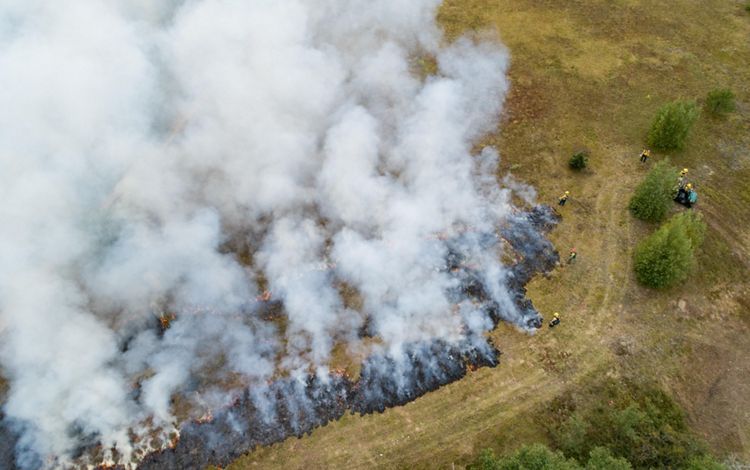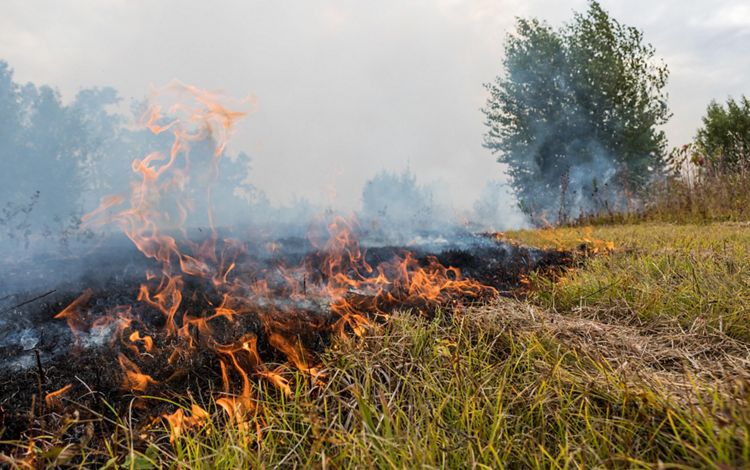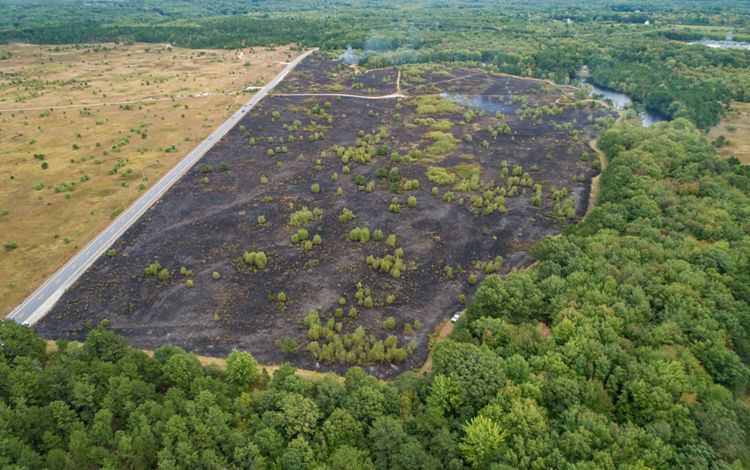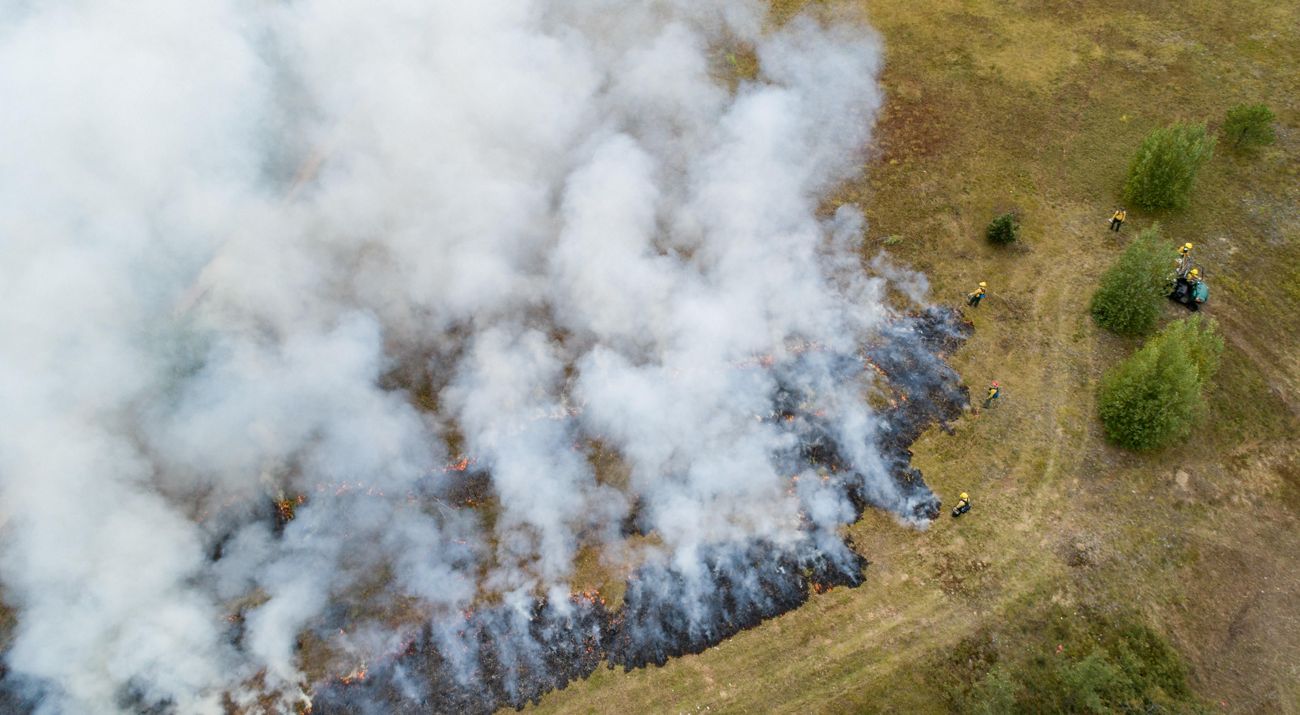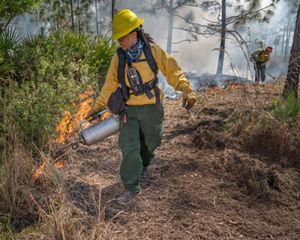The fire started in the southwest corner of a field filled with grasses and wildflowers, young birches and scrub. Plumes of thick smoke rose into an already clouded sky, carried aloft by a steady breeze from the northeast. The blaze moved quickly along the dry ground yet burned for hours—a circle of darkened ash closing in on the last column of flame and smoke in the center. When it was over, 56 acres was charred to black. For the fire team assembled around the untouched margins of the still-smoldering field, there was no mystery to the origins of this fire. After all, they started it. This was a controlled burn at Kennebunk Plains Preserve—and it began much earlier.
Planning for a Controlled Burn
Jon Bailey, The Nature Conservancy's southern Maine preserves manager, was the "burn boss" for this fire. He's nationally certified for this work and responsible for planning, alerting neighbors and local fire departments, organizing crew assignments, and providing oversight and direction during the fire. For days prior, Bailey monitored weather forecasts to determine predicted wind speeds and direction, precipitation, relative humidity, and other factors that indicate whether conditions would be favorable in the area. Two days before the scheduled burn, he sent out the "GO" email to the crew.
On the day of the burn, twenty women and men gathered at a staging area near the site. Donning fire-retardant bright yellow shirts and dark green pants, helmets, goggles, gloves, and rugged boots, this day's group included TNC staff from Maine and New Hampshire, young people serving on an AmeriCorps NCCC Fire and Conservation Crew and volunteers who have completed the rigorous training required to be on the fire line.
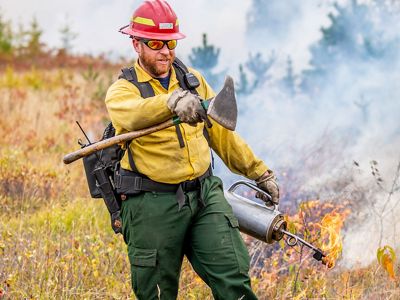
Bailey called the team together and led a briefing of the day's assignments and activities. After splitting the crew into two teams, he lifted a map of the site and pointed out natural fire breaks, water sources and safe zones—areas that can provide protection from the flames in an emergency. Then he explained the plan: "We'll meet at drop point 'D' to begin the test fire, and from there Team One will move toward drop point 'C' and Team Two will go to drop point 'E'."
After a final radio check, the teams moved into position, including two large pickup trucks modified with specialized fire equipment and one side-by-side four-wheeler that can nimbly move along the fire line. The trucks set up back-to-back, ready to move toward their assigned check points in opposite directions along a cleared and mowed grassy track that surrounds the entire field.
And then it starts.
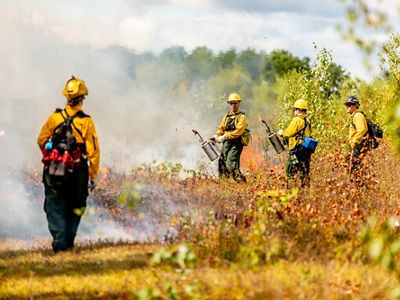
Volunteer Barb Strom touches a lighter to the little blue stem grass at her feet. As the grass ignites, she lights the wick on the end of her drip torch, a handled metal container filled with a gas-diesel mixture, and tips it just enough to drizzle liquid flame into the tall grasses along the track. This "test fire" looks good to Bailey and he directs the teams to move out.
More drip torches appear as the teams move away from each other at a steady, smoky pace. Water from the trucks is sprayed out ahead of the torches to fire-proof the grassy road, and other team members walk alongside with hoes to extinguish any escaping embers. The flaming procession moves ahead slowly like a billowing marching band—with orange tongues dancing to an uneven rhythm enveloped by their own haze. So why are they burning this field?
Using fire to Manage for Habitat
"The Nature Conservancy uses fire as one of the important management tools to maintain certain types of landscapes in TNC's preserve network in Southern Maine and New Hampshire," explains Bailey. "This technique maintains the grassland community necessary for nesting habitat for specialized bird species, as well as fire-tolerant plants that are well-adapted to the nutrient-poor soils at a place like Kennebunk Plains."

Without burning, the grasslands would be invaded by pitch pine, gray birch, red oak, white pine and pin cherry. Fire creates a natural change in the vegetative structure and composition, creating new openings and initiating a nutrient release that increases food availability for many species.
It also maintains the largest known population of northern blazing star, a fire-loving species of flowering plant that bursts with vivid purple blossoms every August at Kennebunk Plains.
"Some people express understandable concern about the impacts to wildlife when we burn," says Bailey. "But carefully controlled fires allow creatures to escape to unburned areas of the preserve and are necessary for the health of the entire grassland ecosystem."
"It's also a matter of safety for our neighbors," he adds. "By periodically burning away excess fuels, the risk of intense and uncontrolled wildfires is greatly reduced."
Quote: Jon Bailey
This technique maintains the grassland community necessary for nesting habitat for specialized bird species.
Everyone Has a Role to Play
Contrasting with the crew's yellow, Bailey's scarred orange helmet can be seen through the haze all around the burn area, and his voice frequently breaks in over the radio.
"Burn boss-weather."
"Go weather."
"Can I get a reading?"
"Stand by."
Birch Malotky is a TNC burn crew member from New Hampshire, and she's today's weather monitor. Every hour, Birch finds an unburned area and uses specialized field tools to determine wind speed and direction, as well as relative humidity. She writes them in her weather log and then calls them out to the burn boss on the radio.
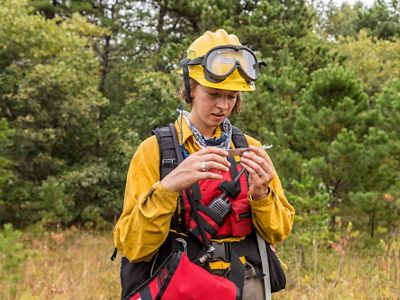
Bailey's plan uses wind speed and direction to help control the pace of the fire. That's why he started this burn in the southwest corner of the field. The northwest breeze, coming from the direction he wants the fire to go, helps temper the speed of the flames. As the burned grasses become "black," the unburnable fire break on the margins grows wider and wider. So, when the two teams moving around the burn area in opposite directions eventually converge at the other side, the flames arrive to meet them. And that's where it ends.
After hours on the line, the teams finally head back to the staging area and start removing their gear, exposing the soot and grime now painted on their faces. Soon Bailey arrives and gathers them for an after-action review of the day's work. After he starts the discussion with his own observations, the team leaders talk about what went well and what could have gone better on their end of the fire line.
A small crew will be staying until the last puff of smoldering is out for good—as long as it takes. But most are heading home, tired, sore and ready for the next email from Jon Bailey that says "GO."
Scenes from a Burn

